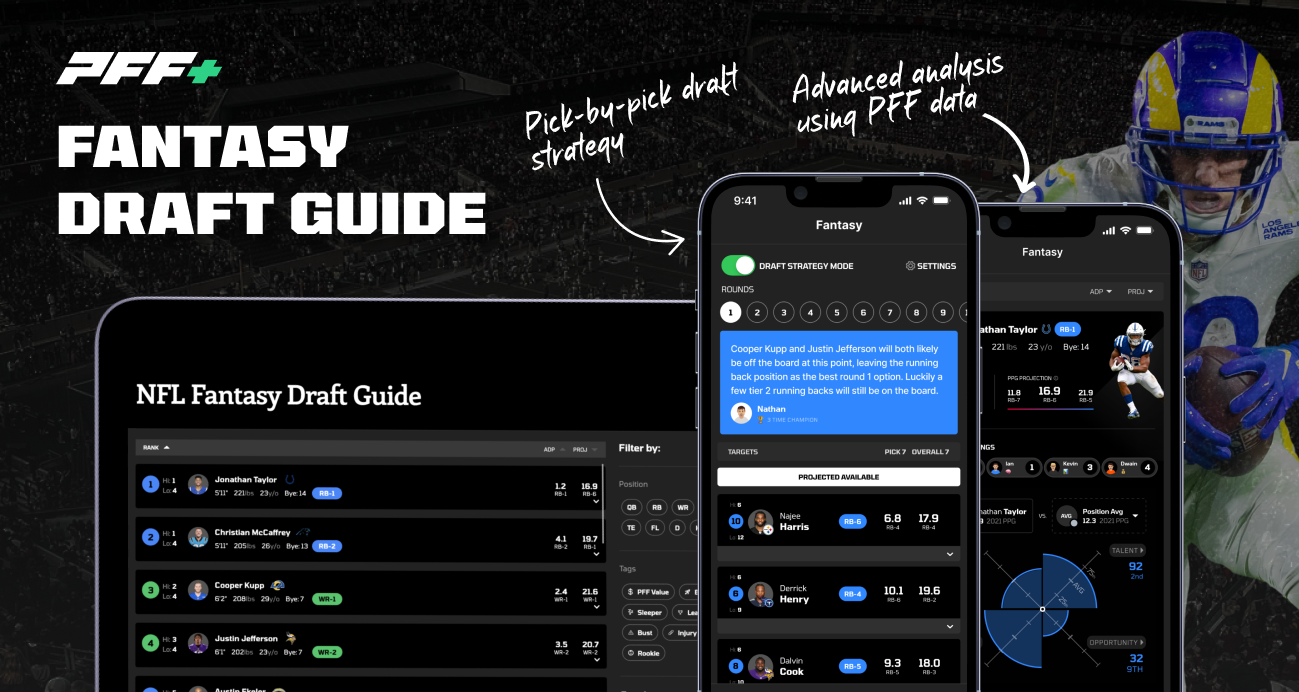Identifying breakout performers is one of the fantasy football community’s greatest obsessions each offseason. Like the frenzied floor of the New York Stock Exchange, analysts are scouring the tape searching for signs of stocks that are ready to surge higher in value. After all, adding those commodities to our fantasy rosters could provide us with the upside needed to build a winning portfolio.
The goal of this article is three-fold:
- Identify when receivers typically break out based on their experience
- Understand the data points that often precede production leaps
- Apply our learnings from the first two points to identify potential breakouts for 2022

METHODOLOGY
For this article, a breakout is identified as a receiver reaching the WR1 or WR2 threshold for the first time in their career. This method was chosen because the high-end WR1 range of outcomes differs much from low-end WR2. The average top-six wide receivers have averaged 330 points versus 223 for the receivers 18 through 24 since 2011.
The thresholds are calculated based on PPR scoring for the corresponding receiver rank since 2011. Here are the threshold averages for the top-60 receivers:
- WR1 (12): 263
- WR2 (24): 215
- WR3 (36): 180
- WR4 (48): 155
- WR5 (60): 128
Using averages to drive thresholds, we create more accurate and consistent benchmarks because we don’t overrate or underrate finishes based on anomalies that can occur in a singular season. Sometimes we see a score that would typically be a WR3 season end up as a WR2 and vice versa, which is what we want to avoid.
WHEN DO WIDE RECEIVERS BREAK OUT?
Before we go too much further, it is important to get a macro understanding of how a receiver’s experience plays a role in delivering fantasy football points. One way to do that is by simply pivoting a receiver’s production versus experience to highlight the distribution of outcomes.

For example, 85% of WR1 performances over the last 11 seasons have come from second- to eighth-year receivers, and a similar distribution plays out for WR2 finishes (83%). On the other hand, a WR3 finish is more plausible in Year 1, and it appears more receivers can attain that level in years nine and 10.
This all makes sense. As receivers mature into their second seasons, we begin to see them make up a larger portion of the WR1 and WR2 finishes. It also tells us that as receivers age, they make up less of the high-end outcomes we seek in fantasy. However, it doesn’t tell us how often these performers are breakouts versus frequent flyers, which is our next step.
We need a visual that tells us what percentage of the time a player finishing as a WR1 or WR2 did so for the first time in their career. In other words, were they breakout performers or repeat performers?
For this exercise, the data pool includes players drafted since 2011 because we will pull in advanced data points later that don’t date back to the early-career days of players like Andre Johnson and Larry Fitzgerald.
When analyzing the table below, it is also important to remember that everything is based on a player’s previous grouping (i.e. WR1, WR2, WR3) high-point. Once a receiver has finished as a WR1, he can’t have a first-time WR2 finish even if he technically didn’t have one before making it inside the top-12.

As we would expect, a huge proportion of Year 2 finishes were breakout performances across the board, with Year 3 following closely behind. Interestingly, the percentage of players reaching WR1 status for the first time doesn’t fall off as quickly as we might anticipate.
It is important to note that we could see large percentage swings in the future given how sample sizes diminish the further we move away from Year 2. For example, nine (82%) out of 11 receivers to finish as a WR1 in their third season were first-timers and three (60%) out of five WR1 finishers in Year 6 were first-timers. Overall, the sample sizes diminish equally across performance buckets so the same can be said for WR2s.
It is also interesting that we see a stark and broad drop-off at Year 7, which adds some context to the data we saw earlier for PPR finishes across all receivers from 2011 to 2021. While we continue to see some late-career players post top finishes, they aren’t coming from first-timers — those players have already been there before.
When we group the breakouts by top-24 rather than WR1 and WR2 we see that the majority of top performers are frequent flyers once we get to years four through six, and a similar scenario plays out for the top-36 — but the drop starts in the third year. Below is the same chart from before but displaying the repeat performer percentages.

Key Takeaways:
- Wide receiver breakout performances are more abundant from a percentage and raw numbers in Years 2 and Year 3.
- Most top-24 performers have been there before once you get to Year 4, but many of the WR1 performers are still first-timers through Year 6.
WHAT ARE THE LEADING INDICATORS FOR A BREAKOUT CAMPAIGN?
Now that we understand breakout time frames based on a player’s experience trajectory, we can focus on identifying leading indicators. Given the data we have seen, the first one is probably pretty obvious — previous fantasy finishes.
WR1 breakouts by experience and the player's previous career-high fantasy finish
| Year 2 | Year 3 | Year 4 | Year 5 | Year 6 | Total | |
| WR1 Breakouts | 7 | 9 | 2 | 4 | 3 | 25 |
| Prior WR2 | 1 | 5 | 2 | 3 | 2 | 13 |
| Prior WR3 | 3 | 3 | 0 | 0 | 0 | 6 |
| Prior sub-WR3 | 3 | 1 | 0 | 1 | 1 | 6 |
Of 25 WR1 breakouts, 52% were players who already had a WR2 finish on their resume, and another 24% came from players with a WR3 finish already to their name — which equals 76%. The easiest way to find the next WR1 is by looking at previous WR2 and WR3 performers. We can also see that players aren’t as likely to make a jump to WR1 with only a WR3 finish after Year 3.
It is also possible to mine the sub-WR3 group for signals that could indicate a future fantasy breakout. For this task, I pulled in PFF receiving grade, yards per route run (YPRR) and targets per route run (TPRR) data and built benchmarks based on WR PPR finishes since 2011.
| PFF Receiving Grade | YPRR | TPRR | |
| WR1 | 84.9 | 2.28 | 26% |
| WR2 | 73.9 | 1.97 | 22% |
| WR3 | 71.6 | 1.75 | 21% |
For the rookie receiving grade heading into Year 2, I used a slightly different scale than the one above based on previous research but used the grades above from Year 2 onward.
Adding this layer of analysis identified four out of six WR1 breakouts that didn’t already have a WR2 or WR3 finish upon breakout.
- Year 2: Allen Robinson II flashed a WR2-worthy TPRR as a rookie (23%)
- Year 3: Cooper Kupp had eclipsed the 75.0 receiving grade as a rookie plus posted a WR2 YPRR (2.04) and then managed a WR2 receiving grade (79.1) and YPRR (2.26) in his second year
- Year 5: Doug Baldwin posted an 80.4 rookie receiving grade along with a 24% TPRR and 2.24 YPRR and added two more WR2 grades in Year 3 (78.9) and Year 4 (75.6)
- Year 6: Robert Woods delivered a WR3 worthy TPRR in his fourth season and added WR2 marks in PFF receiving grade (76.8), TPRR (22%) and YPRR (2.17) in his fifth year
This means we had some sort of leading signal on 23 out of 25 WR1 breakouts (92%).
Exclusive content for premium subscribers

WANT TO KEEP READING?
Dominate Fantasy Football & Betting with AI-Powered Data & Tools Trusted By All 32 Teams
Already have a subscription? Log in



 © 2025 PFF - all rights reserved.
© 2025 PFF - all rights reserved.